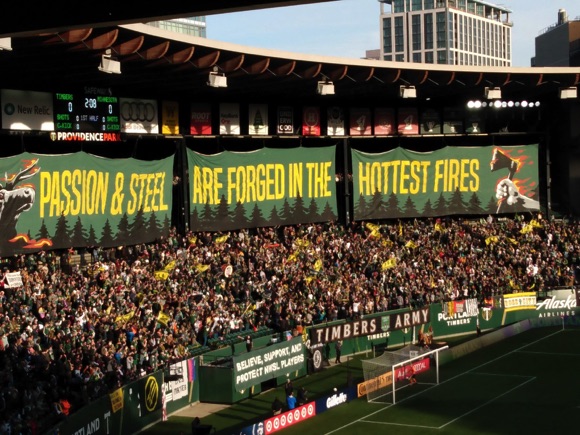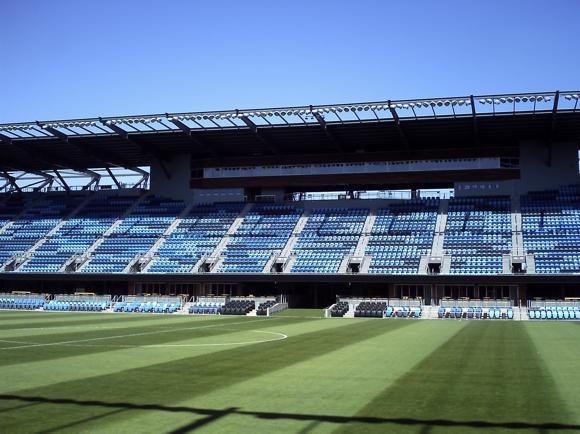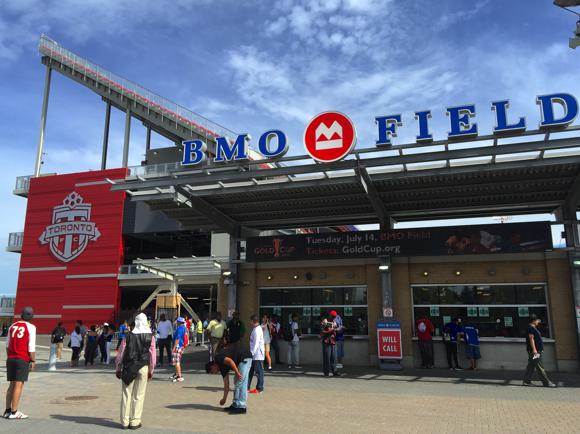A fan’s guide – the club from formation to today
Atlanta was an MLS success story waiting to happen. Attracting the highest average attendance in MLS every non-pandemic year since the team’s foundation in 2017, Atlanta United played before an all-time record crowd of 73,019 when it won its first MLS Cup at Mercedes-Benz Stadium a year later.
More than that, extraordinary considering Atlanta was not an MLS city for the league’s first two decades, it was not a World Cup 1994 venue and it didn’t even host any matches for the Olympics it staged in 1996 – but this will be soon be the home of U.S. soccer.
Under Arthur Blank, the entrepreneur who has steered United and Mercedes-Benz Stadium to the forefront of the game in the States, the superb training facilities he built and the groundswell of support his team has generated have led to the U.S. Soccer Federation moving its base from Chicago to Atlanta.
Logistic also helps. Atlanta, built as a transport hub in the railroad era, is home to the world’s busiest airport, as well as huge multinationals – Coca-Cola, The Home Depot – whose sponsorship dollars find their way into sport. Blank, co-founder of the latter, purchased NFL’s Atlanta Falcons in 2002, set up the Atlanta United MLS franchise and saw the bigger picture.

A stadium fit for the Super Bowl, suitable for the World Cup, a stage filled to near capacity every game for football and soccer, has elevated the city to such an extent that there’s talk of USNMT making a regular home here, something it has never had. Columbus is its talismanic touchstone, Washington’s RFK Stadium is no more, England has its Wembley, France her Stade de France – why not Atlanta, where there wasn’t top-level soccer for nearly four decades until 2017?
This extraordinary recent phenomenon brings the development of league soccer in America full circle, as Atlanta was the cradle of NASL from 1967 onwards. Atlanta Chiefs may have won the inaugural NASL championship a year later but there is far more to this story than that single item of silverware.
Like United, Chiefs was a venture engineered by a sports mogul looking to branch out from their successful franchise in a popular American sport.
In this case, it was Dick Cecil. His death in August 2023 revealed just how far his influence reached. A baseball player and coach at college, Cecil joined Milwaukee Braves as a scout, then worked his way up the ladder there. With the team stuck in a rut, long-term Braves owner Lou Perini sold it to Chicago businessman William Bartholomay, a friend of Ted Turner. The later founder of Atlanta-based TV news network CNN was a major mover and shaker in Georgia.

Lured by the potential TV revenue of a fast-growing metropolis, Bartholomay wanted to move the Braves to Atlanta, where it would be the first baseball team in the Deep South. The other attraction was Atlanta-Fulton County Stadium, aka Atlanta Stadium, built by Ivan Allen Jr., Mayor of Atlanta from 1962, who created a roadmap for substantial city development free of segregation.
With Atlanta opening up to so many urban initiatives, as head of Braves Productions events promoters, Cecil put the Beatles on at Atlanta Stadium in 1965, the only time the group played the city. A year later, despite protests and death threats to the mayor, Braves set up there too, along with Atlanta Falcons NFL team.
It was also the year of the World Cup in England. Impressed with the potential he saw in the sport, and looking to use Atlanta Stadium to the maximum, Cecil decided to bring soccer over. The man he convinced to help him was Phil Woosnam.
An intelligent inside-forward coming to the end of his playing career at Aston Villa, the former Welsh international and university graduate saw nothing but opportunity where others might have seen a soccer desert in Atlanta. Head coach and star player of the newly founded Atlanta Chiefs in 1967, Woosnam conducted 390 soccer clinics around Georgia in that year alone, introducing the sport to 20,000 baby boomers. Soccer leagues and programs were set up at Georgia State University and the YMCA.

With Chiefs joining the short-lived National Professional Soccer League (NPSL) the same year, Woosnam persuaded his former teammates Vic Crowe, Peter McParland and Vic Rouse come on board. While average crowds of under 7,000 in the 50,893-capacity Atlanta Stadium might seem like an underachievement, it must be set in the context of Atlanta itself, where the number of people who had actually seen or played soccer pre-Woosnam would have been in the low hundreds.
The NPSL morphed into the 17-team NASL the following year, bringing scores of experienced players over from Europe. Seizing the moment, Cecil organized an exhibition match involving the recently crowned champions of England, Manchester City, facing Atlanta Chiefs at Atlanta Stadium. Not only did City lose, the club insisted on a rematch, which it lost again.
Towards the end of what would be a memorable inaugural season, Cecil brought Pelé’s Santos over for a similar showcase friendly, one that attracted 25,000 spectators. Little did anyone, least of all Pelé, realize that Woosnam and the Brazilian star would be crossing paths again to transform soccer in America.
A month later, with goals from McParland and a little-known striker from the South African township of Soweto, Kaizer Motaung, Chiefs beat San Diego Toros in front of nearly 15,000 at Atlanta Stadium to win the inaugural NASL trophy. Not only was Woosnam coach, it was he and Cecil who had spotted Motaung when on their global scouting tour before NASL started.

Plucked from team trials in Zambia, Motaung made his debut in Atlanta against Manchester City, coming off the bench to score two. Top league scorer and Rookie of the Year that first season, Motaung then returned to Soweto at the height of Apartheid, formed his own football team partly named after his former club, and duly made Kaizer Chiefs the most successful and popular side in South Africa. Their badge still echoes the one on Motaung’s shirt back in ’68.
After Cecil’s death in 2023, Motaung was quick to pay tribute to the former Atlanta Chiefs chairman who had transformed his life: “I still feel very honored to have been part of the first team from Atlanta to win a championship in any sport in 1968. I held him in very high esteem. He was a kind gentleman. Atlanta Chiefs is the reason there is a Kaizer Chiefs today in South Africa.”
Leaving Atlanta Chiefs as NASL Coach of the Year, passing the baton to Vic Rouse, Woosnam doubled down on his mission by becoming Commissioner of an NASL in dire need of transformation. That title-winning year, Chiefs had attracted an average attendance of under 6,000 – almost twice the meager figure for the league as a whole.
Teaming up with a former sports writer from the UK, Clive Toye, who had reached the pinnacle of his career at the 1966 World Cup before coming Stateside to oversee Baltimore Bays, Woosnam set about selling the NASL, and soccer itself, to the nation. With very little budget but free use of the telephone in the visiting team’s locker room at Atlanta Stadium, the pair plotted, begged and cajoled to keep the NASL alive.

In 1975, they would use the same tactics to achieve the impossible, and bring Pelé to America. In two short, crazy years, he and Cosmos transformed the sport in the States.
Woosnam and Toye would be rewarded with their place in the National Soccer Hall of Fame, although the Welshman would not live to see the extraordinary success of Atlanta United, exactly 50 years after he set up hundreds of soccer clinics across town and beyond. He died in Dunwoody, Georgia, in 2013.
The last NASL final to feature Chiefs took place in 1971 – and in front of 3,218 at Atlanta Stadium. Surprisingly, Atlanta hardly benefited from the huge spike in soccer popularity in the immediate after of the Pelé era. The Chiefs franchise had folded in 1973, and it was Dick Cecil who convinced media mogul Ted Turner to part with $1.5 million to bring the Caribous of Colorado to Georgia.
Apart from having a remarkably unsoccer-like name, these one-season-only Caribous sported uniforms centerpieced by a leather fringes across the chest, like a cowboy jacket. It didn’t bode well, nor did it end well, but at least one of the most powerful men in America had discovered sport. Shortly afterwards, he purchased the Atlanta Braves baseball team, making them one of the most successful of the era.
Soccer in Atlanta, meanwhile, was so overshadowed that no games were played in town when the city hosted the Olympics in 1996. It had also been overlooked for the 1994 World Cup, and inaugural MLS season that sprang from it. Atlanta Stadium was knocked down soon afterwards.

While MLS went ahead with only two short-lived teams in the Southeastern United States – Tampa Bay Mutiny and Miami Fusion – Georgia was not without soccer. Several players from indoor side Atlanta Magic jumped ship to newly founded Atlanta Ruckus in 1995, reaching the final that same year of the A-League, originally the American Professional Soccer League (APSL).
Starring defender John Doyle and attacking midfielder Bruce Murray, both key members of USMNT at the 1990 World Cup, Ruckus lost to Seattle Sounders over three games, one in front of a few thousand at Adams Stadium, a high-school football pitch in DeKalb County.
By 1999, Ruckus had become Atlanta Silverbacks, named for a popular gorilla at the City Zoo, where the press conference took place announcing the change. Initially based at DeKalb Memorial Stadium, another high-school football ground, Silverbacks foreshadowed much of what would follow nearly a decade later. First, their colors were red and black, as Atlanta United’s would be.
Secondly, they attracted a raucous independent following, particularly after moving to their own soccer-specific stadium, a rarity in 2006. Although capacity at Atlanta Silverbacks Park was only 5,000, this was always intended to be expanded, perhaps three or four times, an acceptable size for MLS.
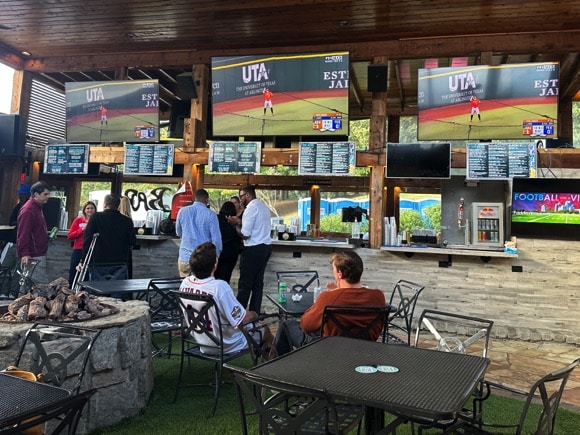
Silverbacks were inaugural members of the National American Soccer League in 2011, the name inspired by the Pelé days of NASL. To underline this, its most successful side was New York Cosmos, which beat Silverbacks at Soccer Bowl 2013 in front of 7,211 at Silverbacks Park. The solitary goal came from Marcos Senna, the Villarreal legend who just left the Spanish club for Cosmos after a decade of unprecedented achievement.
Silverbacks only lasted until 2015, by which time talk had turned to MLS. Atlanta Falcons football team, originally based at Atlanta Stadium, had moved to Georgia Dome when it opened in 1992. Though damaged by various freak weather occurrences, it had successfully hosted a number of international friendlies, attracting crowds of 50,000-plus for four games involving Mexico. In 2016, 70,511 watched the CONCACAF Gold Cup Semifinals, a doubleheader of U.S. v. Jamaica and Mexico v. Panama.
While the stadium, too expensive to rebuild, was facing demolition, the concept of an arena shared regularly between sports was still a sound one. Atlanta’s substantial Hispanic soccer following was another key factor.
Like Dick Cecil before him, the man behind the proposed new soccer franchise, home improvement mogul Arthur Blank, was a major player in Atlanta sports ownership. Buying Atlanta Falcons in 2002 and close to picking up Atlanta Braves four years later, Blank knew that the city needed MLS – it was the largest metropolitan area in the States without it.
Linchpin to the initiative was the long-established Falcons and their need for new home, one that could also stage huge sporting occasions.

With its signature retractable roof, Mercedes-Benz Stadium is located downtown, with superb links by public transit. The various supporters’ groups, the leading one established before United was even founded in the Silverbacks era, didn’t have far to schlep and soon bought season tickets in their tens of thousands.
Also having a say in the club colors of red, black, and gold, part Falcons, part Silverbacks, and the name of “United” itself, these committed followers filled Bobby Dodd Stadium to its 55,000 capacity for most of the 2017 season. Steeped in local history – the stadium dated back to 1905, attached to Georgia Tech, a college built as part of the reconstruction following the devastation of the American Civil War – the setting was apt.
This was no high-school football field miles from town but a historic landmark where Georgia Tech, the Yellow Jackets, had created sporting legends, such as the 222-0 win over Cumberland College in 1916. It had even hosted soccer for a single season, when Atlanta Chiefs played as Atlanta Apollos during 1973.
United’s first club president was Darren Eales, who had played the game at grassroots and collegiate level on both sides of the Pond, and held prestigious positions behind the scenes at Tottenham Hotspur. Cambridge-educated Eales would help engineer the Atlanta’s swift rise to success, and oversee the operation before being snaffled up by Saudi-backed Newcastle United in 2022.

First hiring the coach who had recently taken his native Argentina to the World Cup Final of 2014, Gerardo “Tata” Martino, United strode out in their old-school red-and-black jerseys (earning the club the nickname of the Five Stripes) to face New York Red Bulls on March 5, 2017.
Despite an early goal from Argentine attacking midfielder Yamil Asad, Atlanta suffered an initial defeat. It only took a week before Venezuelan international Josef Martínez grabbed the limelight, and a hat-trick at Minnesota United. Top club scorer and member of the MLS Best XI for that season, the former Torino striker smashed all records the following year as Atlanta United romped to a first MLS Cup on home soil.
The fastest player to reach six hat-tricks in MLS, after 44 games in July 2018, Martínez also hit a best-ever 31 goals in a single season, bettered by Carlos Vela the following year. MVP in the League, in the All-Star Game (when he scored against Juventus in Atlanta), and in the MLS Cup Final, the quick-footed forward was the perfect Atlanta hero.
As first witnessed in 2017, his understanding with Paraguayan international Miguel Almirón, a right midfielder of rare football intelligence, proved lethal. The Five Stripes won seven out of eight in the spring of 2018, tearing through the Playoffs in front of 70,000 crowds against New York City and New York Red Bulls.

The final, also at Mercedes-Benz Stadium before a record 73,019 attendance, turned on an expert finish by Martínez and a classic save by another Atlanta cornerstone, keeper Brad Guzan. The veteran U.S. international and former Aston Villa stalwart had enjoyed new lease of life since joining the Atlanta project at its inception in 2017. Marshaling the midfield from the back as ever, veteran Jeff Larentowicz was another hire from the start.
The win over Portland was Martino’s last game in charge. In came Ajax legend Frank de Boer, keen to re-establish his reputation as a coach following a disastrous, a mercifully short, spell at Crystal Palace the year before. While Martínez still hit 33 goals in all competitions, including the U.S. Open and Campeones Cups won for the first time, he missed the interplay with the mercurial Almirón, since sold to Newcastle.
German-born, U.S. international Julian Gressel, a stalwart in Atlanta’s first two seasons, came to the fore to open the scoring in the Eastern Conference Final against Toronto, but it wasn’t enough for United to defend the trophy.
Apart from the pandemic, 2020 was marked by changes of coach and a long-term injury to Josef Martínez. United didn’t really get back into gear until 2023, when former Celtic striker and Greek international Giorgos Giakoumakis in a run to the MLS Playoffs. With fewer Latins in the side, however, average attendance has dropped below 50,000, which is still the best in the league by a long way.
As Atlanta prepares to co-host the 2026 World Cup, the family of Dick Cecil is putting the finishing touches to the movie and documentary projects this NASL pioneer was working on before his death in 2023.
STADIUM GUIDE
The field of dreams – and the story behind it
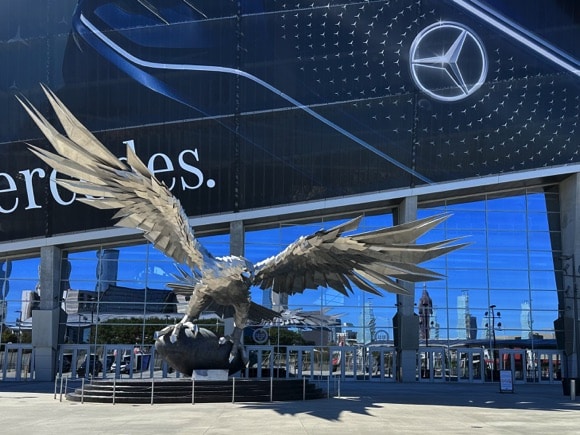
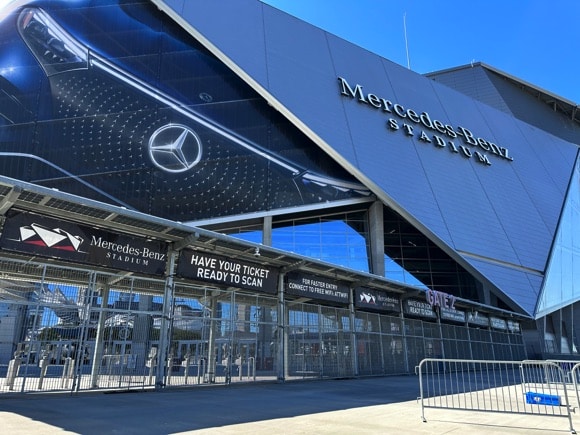
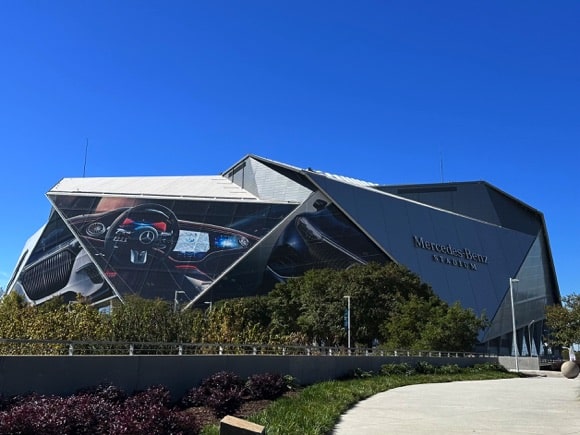


The largest stadium in MLS, Mercedes-Benz Stadium has elevated Atlanta’s sporting status to global level. One of only three American cities to have hosted the Olympics, Atlanta had a flagship stadium in the Georgia Dome but its limitations as an indoor venue functional in appearance led to it being demolished rather adapted for contemporary use.
True, the Dome had hosted the basketball tournament for the 1996 Games, two Super Bowls and several soccer internationals mainly involving Mexico, but it was considered superfluous to requirements. Alongside, to replace it, Falcons owner and the man behind the Atlanta United MLS franchise, Arthur Blank oversaw the construction of a new, multipurpose arena, its signature look provided by its eight-paneled retractable roof.
As well as allowing for open-air events, the panels lend the stadium its falcon theme, designers HOK responding to their client’s wishes by fashioning a roof in the shape of a bird’s wings, which can fold out or in within ten minutes thanks to 16 linear tracks.
They surround a halo feature over the pitch, lined with a 360-degree video board, and help create a 16-story window along the east side. This lets natural light flood in and provides panoramic views of the cityscape of Atlanta.
The falcon theme is accentuated by the huge sculpture on the northeast corner, by Gate 2. Conceived by Hungarian sculptor Gábor Miklós Szőke, whose huge works guard stadiums in Budapest, Szeged, and Siófok, this huge bird stands 41 feet high, its wing span almost twice as much wide. Manufactured in the Hungarian capital, its individual pieces were shipped piece by piece in four huge containers to America, to be put together there. Transportation alone took a month, assembly a hundred people.


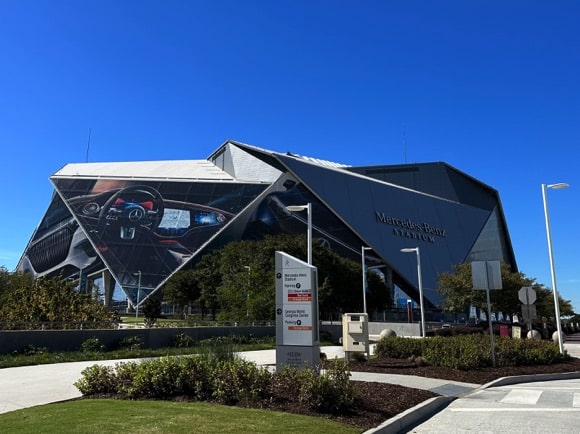
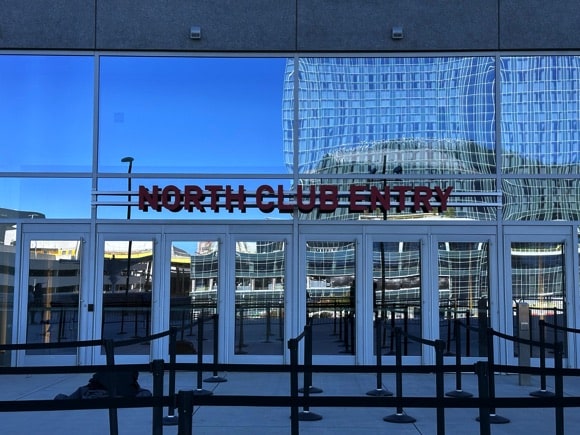
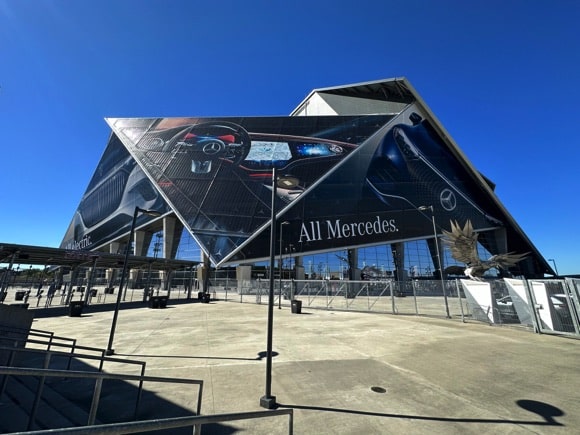
Szőke was a special guest for the Super Bowl in 2019, the venue chosen in 2015 long before the stadium was ready. In fact, when it opened in August 2017, the retractable roof wasn’t yet functioning, the panel mechanism having delayed the unveiling by six months, forcing Atlanta United to decamp to Bobby Dodd Stadium.
The lopsided schedule meant that the team had six straight games at home through September 2017, the whole stadium open for the visit of nearby Orlando City before 70,425 spectators, then a league record for a single match. The venue otherwise operated in soccer mode, the seats in the lower bowl retracted to make room for the wider field and reducing capacity to around 43,500.
Overall cost for this revolutionary arena was $1.6 billion, though the best part of $1 billion was raised from sponsorships, around a third of that figure provided by Mercedes-Benz alone, which owns naming rights for at least two decades.
Atlanta ultras fill The Gulch, sectors 101-102 and 136 behind the east goal, with noise and color, shared with neighbouring sectors 103 and 135. Sitting doesn’t really happen in the Supporters Section – this area is General Admission, so be prepared to stand, jump around and sing for 90 minutes.
Visiting supporters are allocated sector 329 when the stadium is in full capacity mode of 70,000+, 229 when it’s 42,500.
TRANSPORTATION
Going to the stadium – tips and timings


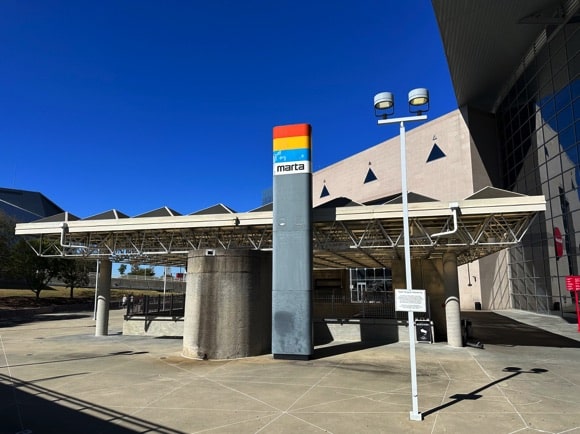
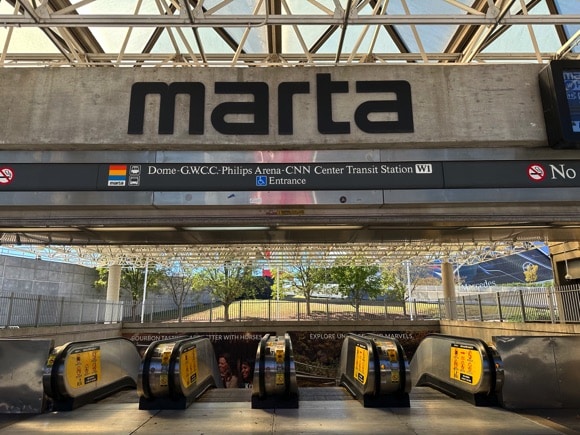

The world’s busiest airport, Hartsfield–Jackson International Atlanta is ten miles (16km) south of Downtown Atlanta, with its own station on the city’s MARTA rapid transit system of rail and buses. This is located in the Domestic Terminal, between the North and South baggage claim areas. A free shuttle links with the International Terminal, journey time 15mins.
To use MARTA, you’ll need a Breeze Card ($2), available from vending machines and MARTA RideStores at stations and major crossing points. Find maps, schedules and updates with the MARTA On the Go App, in Apple or Android versions.
A regular fare ($2.50) entitles you to four free transfers within a three-hour period, so you can get into town, check into your hotel and get to the stadium. A one-day pass is $9, two-day $14, and so on. You can also use your Breeze Card for the Atlanta Streetcar ($1, no transfers onto buses or rail).
The Airport station is at the southern terminus of the Red and Gold Lines, directly linked with Five Points in the center, 20mins away. The stadium is served by two stations on the Green and Blue Lines: GWCC/Philips Arena/CNN Center, and Vine City, only one or two stops from Five Points. The first is the preferred option and closest to Gates 2-4 on the east side of the stadium; the second to is nearest Gate 1 via a Pedestrian Bridge over Northside Drive. This is the west side of the stadium, and the sectors designated for followers of the away team.
From the airport, you’ll find taxicabs at the Domestic Terminal between Doors W-1 and W-2, and at the International Terminal outside the A-1 Door. The standard fare to Atlanta Downtown is around $35-$40. Yellow Cab of Atlanta (+1 404-305-9075) is as good as any.
To park at Mercedes-Benz Stadium, book one of 20,000 spots through its website. On non-event days, use the Silver Deck of the Georgia World Congress Center.
Cyclists can leave their bikes across the street from Gate 2 at 1414 Andrew Young International Blvd NW, Atlanta, GA 30313 thanks to a service run by the Atlanta Bicycle Coalition. Drop off your bike from 2hrs before the game, giving your cell phone number. A text message will include a secure claim ID and the time the service closes.
TICKETING
When, where, how, and how much

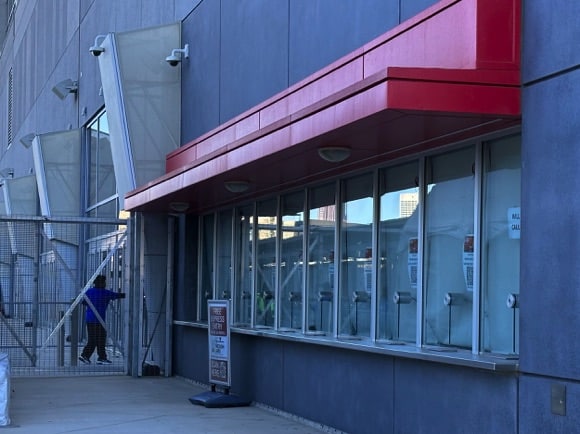
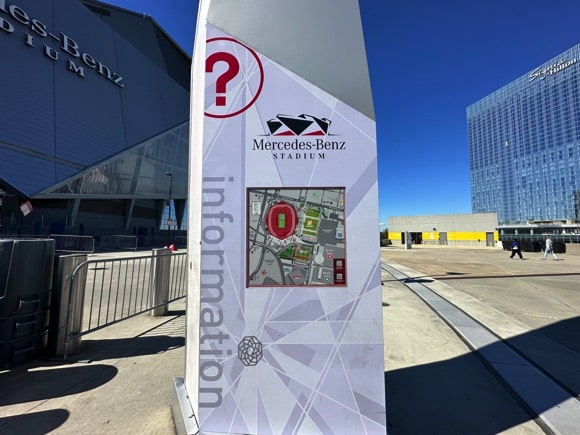
Availability is a major issue at Atlanta, so book your seats early through the club website.
This links through a ticketmaster online booking platform.
The nearest you’ll get to the action is in sectors 116-122 behind the West goal, seats going for around $50-$70. Prices rise to about $80 in sectors 106-107 in the Southeast corner of the stadium. You’ll pay around $100 for a seat in the row above, sectors 206-209.
Children under 33 inches tall may enter for free provided they sit on their guardian’s lap.
The Box Office is open for inquiries on match days, otherwise email the club at fans@atlutd.com. There is no Will Call service.
MERCHANDISE
Jerseys, souvenirs, and all kinds of gear

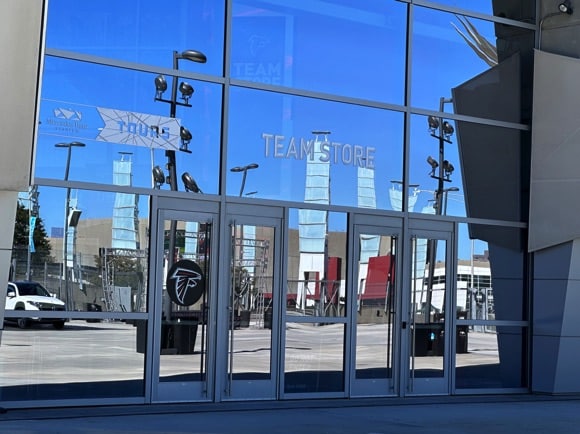
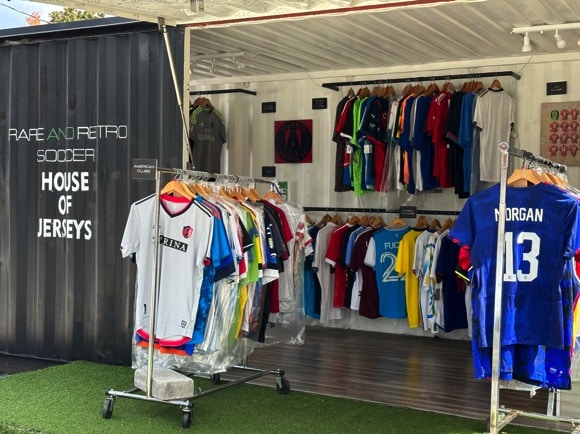

Atlanta United’s main Team Store is located at Section 102, between Gates 3 and 4, with other match-day outlets at Sections 107, 118, 122, and 204. There’s one open through the week on Floor 1 of Atlantic Station mall (230 18th St NW Suite, Mon-Sat 11am-7pm, Sun noon-6pm).
The 17’s kit is always popular, the original jersey that gave rise to the club’s nickname of the 5 Stripes, though the mint-colored away uniform used for 2023 may not stand the same test of time.
If vintage jerseys are your thing, head to Rare & Retro Soccer of Atlanta, 401 Moreland Ave NE, where classic tops from across MLS, the UK, Europe and South America are stocked at a roadside outlet right by the sports-focused Brewhouse Café.
TAILGATING
Enjoy the full matchday experience

From 2023, a new Atlanta United Supporters’ Tailgate and Fan Village operates from four hours before kickoff at 5A Beckwith Court SW, near the junction of M.L.K. Jr. Drive SW and Northside Drive SW.
Ultras group Resurgence offers pre-match revelry for members and future members alike, with no admission charge and beer provided by the local Three Taverns Brewery. Things pack up an hour before the game for the march to the stadium. For evening games during the week, the party moves to a nearby pub.
For family-friendly activities, kids can find plenty of games at the Home Depot Backyard by Gate 1.
stadium tours
Explore the city's home of soccer

Tours of the Mercedes-Benz Stadium ($27, under-12s $22) are offered on various days of the year through its website. Visits last 90 minutes and go behind the scenes to take in the locker rooms, Window to the City from the East side, playing field and skybridge.
Email for details at tours@mercedesbenzstadium.com.
Where to Drink
Matchday beers at the stadium and downtown
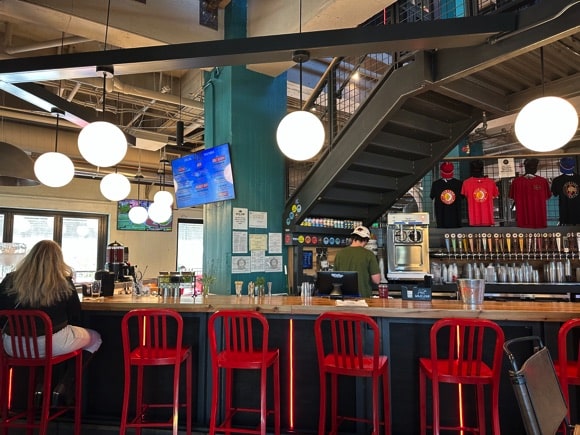






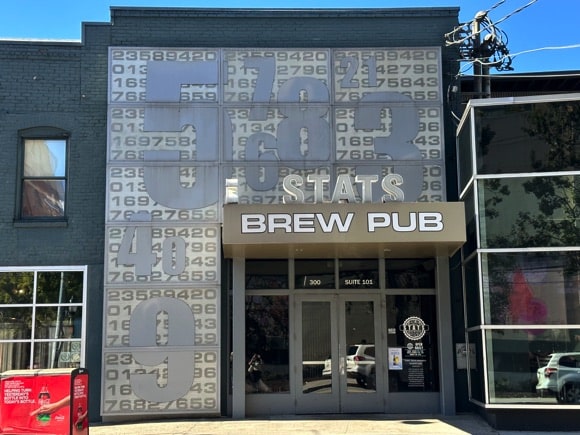

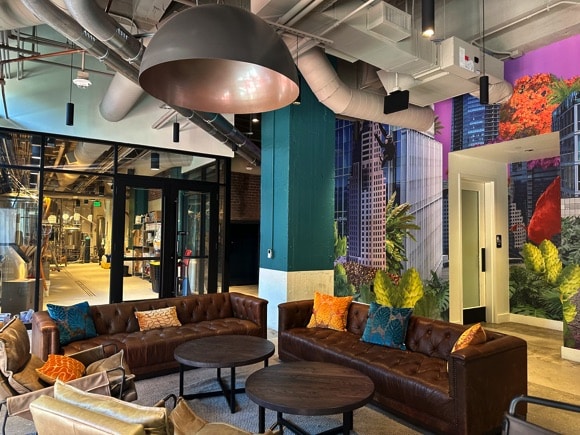


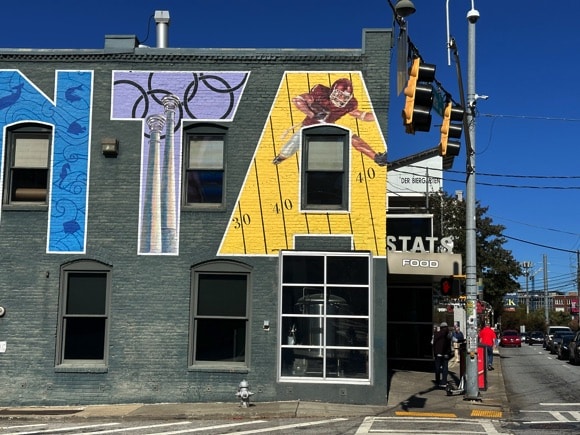
In and around the stadium, some 100 outlets beckon the thirsty and the hungry. Special mention should be made of the Budweiser Beer Garden in sectors 116-121, with its keg wall, and the 100 Yard Club between sectors 308-315, themed after the Falcons and featuring an NFL field’s worth of snacks and beverages.
The nearest locale to the stadium actually overlooks it: The RT60 rooftop bar of the REVERB by Hard Rock hotel right next door. There’s no reservation policy, just walk in after 4pm Friday through Sunday, 5pm on Thursday – dress is smart casual. Downstairs, the Constant Grind dispenses coffee, pastries and fan favorites (meat lovers’ flatbread, chicken and waffles).
Nearby, Wild Leap welcomes Atlanta fans with its own craft beers (Süperlager, Lone Buffalo, Island Haze) in a huge multi-story space including a decked courtyard with chairs in United colors. Also close, alongside Centennial Olympic Park, STATS Brewpub sets itself up as ‘Atlanta’s ultimate sports bar’ with 70 screens and seven separate audio zones, and house cocktails such as Shots on Goal and Assist alongside the $30 beer buckets.





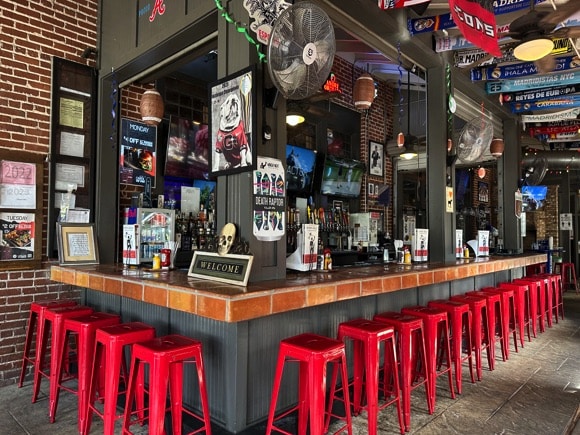







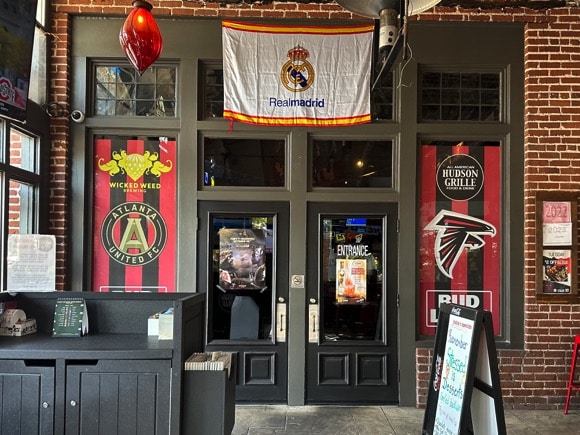
Next door, Der Biergarten is all Schnitzels, Sauerbraten and Steins, liter helpings of Weihenstephan, Bitburger and Paulaner, among many other authentic German brews.
On the West side of the stadium, Restaurant 10 Bar & Grill at 10 Northside Drive NW serves wings, ribs and catfish, as well as signature cocktails such as the Atlanta United Punch with four types of rum. Sports and music clips are screened around the island bar.
‘Atlanta’s ultimate soccer & sports pub’ predates United by two decades – the proudly independent Brewhouse Cafe has been screening matches, and serving fine food and drinks in the Little Five Points neighbourhood Northeast of Downtown since 1997. Today, games are shown on 25 screens, matching the number of ales, lagers, and ciders on tap, including local Three Taverns Rotsting and Scofflaw Basement IPA, and Terrapin Hopsicutioner from nearby Athens, each brew available by the pint and pitcher. Brunch includes cocktails and the beer garden comes into its own in summer. Close by, Hudson Grille is one of six such sports bars in the Atlanta area, known for its wings, ribs and weekday offers. Look out, too, for the seasonal beers on tap.


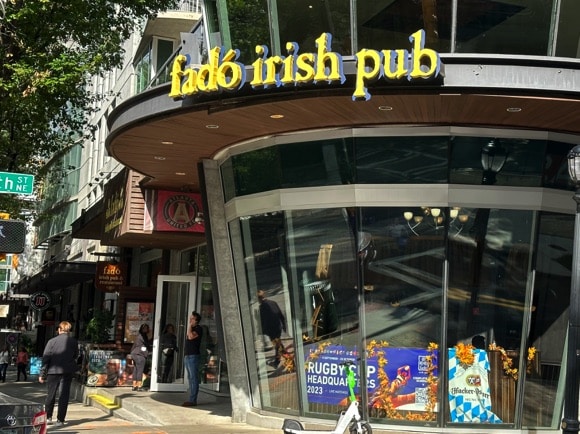







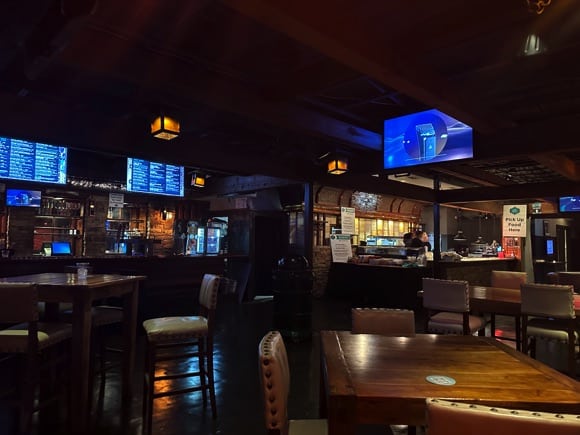
Set in the greenery of Piedmont Park, brew pub and sports bar Park Tavern fills a former stables and golf clubhouse dating back to the early 1900s. It’s also a major live music venue.
Meehan’s serves Guinness, Smithwick’s, bangers & mash, and fish & chips where Macy’s department store used to stock clothes, shoes and accessories, right by Peachtree Center Station. Opened in 2002, it has since spawned three stablemates, all with TV sports.
The other major local Irish chain, Fadó (‘Long Ago’ in Gaelic) at 933 Peachtree Street NE, brings the genre into the 21st century by obtaining its cod from sustainable sources and offering international beers. Branches can be found in Chicago, Columbus, Philadelphia and the Buckhead district of Atlanta.
timeline
Following the local soccer scene

1967 Atlanta Chiefs formed, wins inaugural NASL the following year.
1968 Coach Phil Woosnam leaves Chiefs to develop NASL.
1995 Atlanta Ruckus formed. Plays in A-League final.
1996 Atlanta hosts Olympic Games but all soccer matches played elsewhere.
1998 Atlanta Silverbacks formed from Atlanta Ruckus. Plays at soccer-specific Atlanta Silverbacks Park.
2009 Georgia Dome hosts the first of several soccer internationals before crowds of 50,000+.
2013 The City of Atlanta and Atlanta Falcons reach agreement to build a stadium for NFL and soccer Downtown. Plans afoot to create a new MLS franchise, Atlanta United.
2017 Mercedes-Benz Stadium opens. Atlanta United moves in, attracting record crowds for MLS.
2018 Atlanta United wins MLS Cup at Mercedes-Benz Stadium.
2022 Atlanta named as a venue city for the 2026 World Cup. U.S. Soccer Federation decides to move from Chicago to Atlanta.









